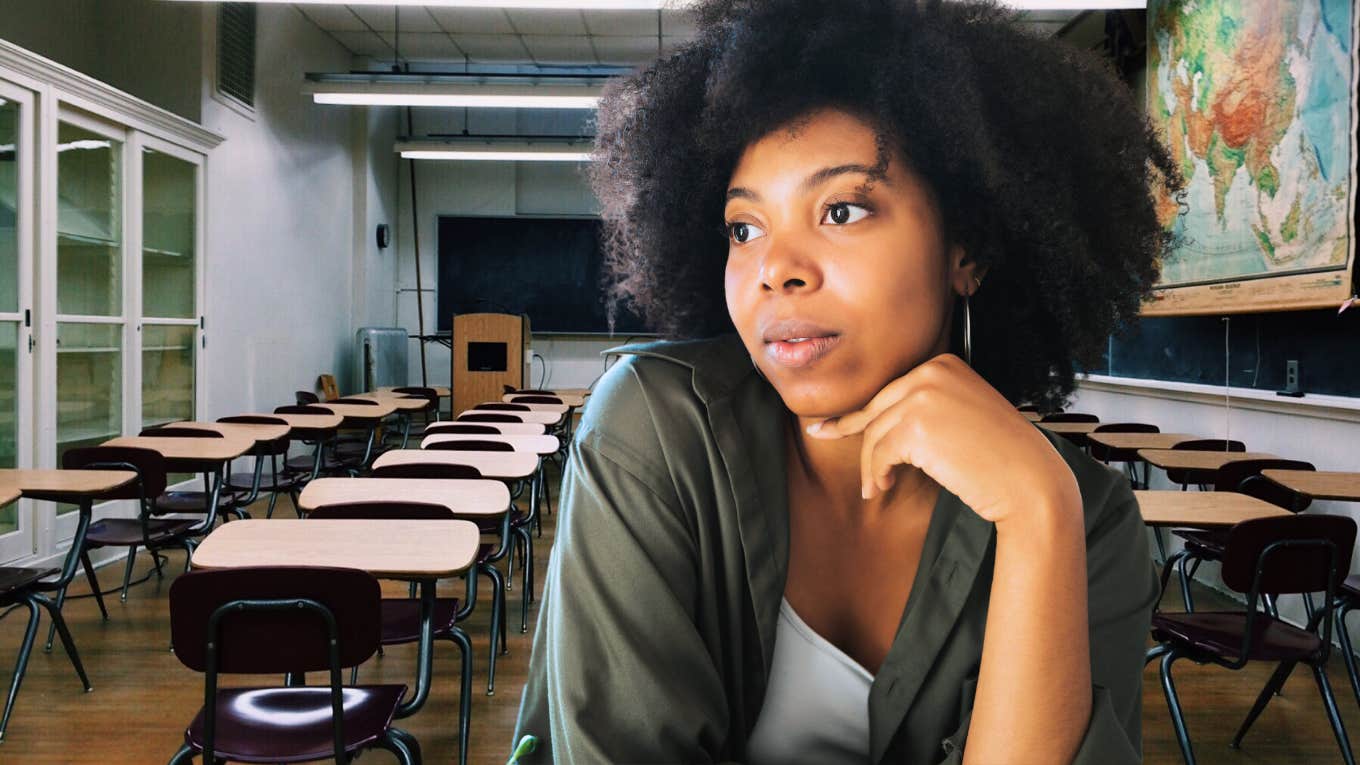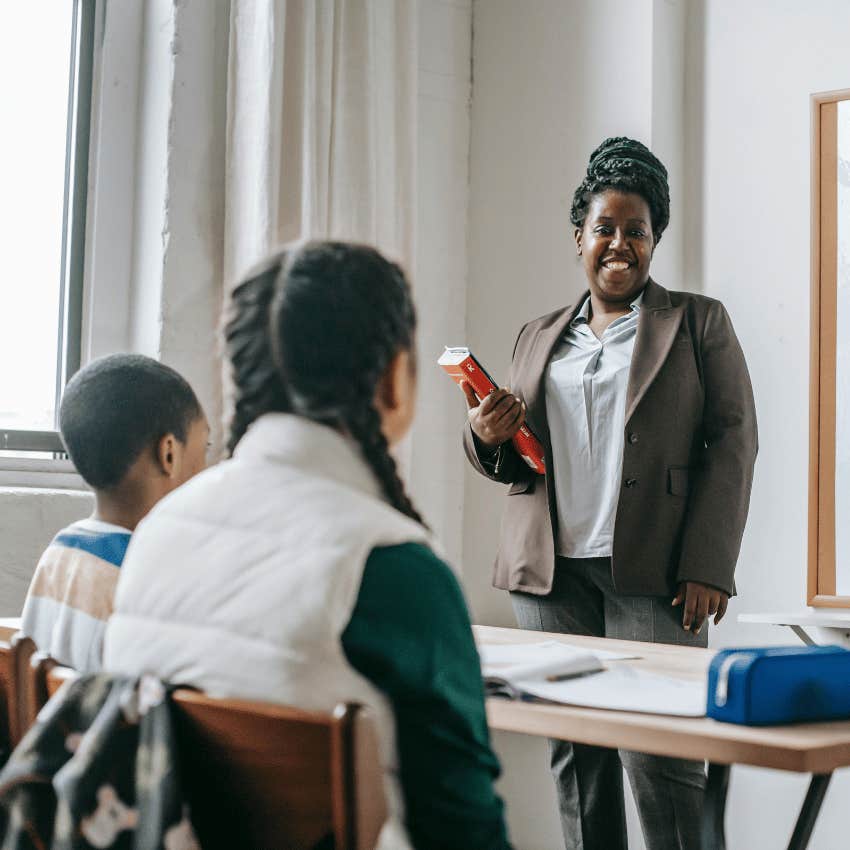The Day A Special Needs Child Broke My Heart — 'She Asked Me To Adopt Her'
The girl who called me mama.
 Getty Images | Unsplash, WOKANDAPIX | Canva
Getty Images | Unsplash, WOKANDAPIX | Canva As a high school teacher, I have had the privilege of forming deep bonds with thousands of children. Miraculously, I could make so many authentic connections with thousands of children in my 20 years in the classroom.
I believe it was my sincerity and authenticity that made children trust me. Children know a phony, and they also know when a teacher genuinely cares about their well-being and has a genuine interest in them as people.
For the most part, this gift came to me naturally. I looked them in their eyes when I spoke to them, and when they spoke to me, I sincerely listened with an open mind and an open heart.
I tried to learn everyone’s names and how to pronounce them correctly. As I got older and struggled with short-term memory issues, this became harder, so everybody became honey, baby, or sweetie, and the children didn’t seem to mind at all. When I first started teaching, I began the school year strong, diving head-first into teaching content.
It took me a while to understand that I don’t teach content — I teach children.
I remember learning in my college courses that children don’t care what you know until they know you care. So, I stopped diving into the curriculum on day one and used the first weeks of school to teach procedures, routines, and behavior expectations, and most importantly, I used this time to get to know my students as unique individuals with hopes, dreams, fears, and unmet needs. I wanted them to know that I cared about all of them.
I transitioned from just seeing names on a roster, discipline records, test scores, or even what other teachers told me about them, and I began to see complex yet beautiful young people with gifts, talents, and intelligence not yet fully realized.
More than anything, I was there to teach them not only to be literate and productive citizens but also to be kind and empathetic citizens who cared about the whole of humanity.
Each new school year began with a clean slate that allowed the students to show me who they were. I, too, allowed myself to be vulnerable and open without compromising the appropriate boundaries that teachers must maintain to have their authority respected.
 Katerina Holmes | Pexels
Katerina Holmes | Pexels
I developed a reputation with students, even when they weren’t my students.
I once overheard a child telling another, “Miss Jade is tough, and you will work your behind off in her class, but you will learn, and she will do all she can to help you learn. She cares.”
He summed up my aim perfectly. That did not just apply to the students on my roster. I formed bonds with students I did not teach as well.
My classroom was always packed with students, many of whom I did not know or teach. They would ask for my help with their schoolwork, and they would ask for advice.
Children of all races enjoyed having me as a teacher, but Black children took special comfort in seeing a Black teacher in the building. Many of them weren’t in my class, but they always hung out in my classroom.
Positive student-teacher relationships have previously been found to increase children’s engagement with school learning and activity, improve academic performance, and reduce the prevalence of children’s externalizing behavior, according to a 2020 study.
A transactional perspective of child development emphasizes the need also to investigate the impact of student behavior on the quality of student-teacher relationships as children actively participate in shaping their environment, according to a 2016 study published in the Journal of Applied Developmental Psychology.
This is how I met my sweet Penelope.
She was a self-contained student who was allowed to socialize and eat lunch with the general population. Although Penelope had never been assigned to my class, she found her way into my room — and my heart.
Like many others, she started calling me “Mama,” a nickname that stuck for a few years. There was something about her that drew me in, and over time, we formed a bond that I will always cherish.
It isn’t unusual for teachers and students to form bonds. When you spend 180 days a year learning with a child, it is easy to make a connection.
I am a very warm and personable person, and I spread that warmth with my babies. When you love children, most of them love you back. They share their thoughts, feelings, and life experiences, and I share some of mine.
Putting effort into establishing trust and strong bonds with students makes it easier for them to learn with you. I loved my relationships with children, but sometimes those relationships could lead to heartbreak. When they hurt in any way, it broke my heart.
Such was the case with Penelope. Every day during her senior year, she came to my class during lunch. At first, she sat quietly, watching as I taught the class. But eventually, I put her to work with the other students.
I quickly discovered she was very intelligent and capable, just like the so-called “regular” kids. Her challenges were more emotional and behavioral than intellectual, a fact that often got overlooked by those who saw only her emotional outbursts and struggles.
She expressed herself through poetry, writing me sweet notes that she would tuck into my desk or leave on my chair. These were her ways of saying, “Thank you,” “I see you,” and most importantly, “I need you.” Our connection deepened, and she began to rely on our time together as a haven from the chaos that often infused her young life.
But then came the day that both of us knew would eventually arrive — her last day before graduation. She entered my classroom as usual, but there was a heavy sadness in the air, an unspoken understanding that our daily routine was about to end.
 cottonbro studio | Pexels
cottonbro studio | Pexels
After a few minutes of small talk, she asked me to adopt her. Yes, you read that right. She wanted me to adopt her.
I was shocked, somewhat flattered, and a whole lot concerned. I’ve had children request many things but never that. “Penelope, you know I can’t adopt you. You are already adopted by two parents who love and adore you.”
She did not agree with me. “They don’t love me. They just want a check. They beat and abused me all the time. Please, Mama, please, please adopt me.”
This encounter broke my teacher’s heart and ignited a maternal fire in me. I knew Penelope well enough to know that she could be very creative with the truth. It was very likely that none of this was true, but as a teacher, I am a mandated reporter, so I had to let the right people know what she said to me.
This poor child had known a lot of pain and abandonment. Her birth mother was addicted to crack, and the state took Penelope away from her. She didn’t stay in foster care long. A couple adopted her.
Penelope is Black, and her adoptive parents are white. She would often lament that she wanted a Black mama who could help her understand her heritage and culture and help her fix her hair. The kids picked on her because her hair was always disheveled. I think she saw in the other Black teachers and me her birth mama.
After trying to reason with her and help her understand why I couldn’t adopt her, she crawled under my desk and curled up on the floor, her arms wrapped tightly around the chair legs, refusing to let go.
“I’m not leaving,” she yelled with defiance, her voice trembling. “I don’t want to go. Please, Mama, take me home with you. Please, adopt me.”
I felt a lump in my throat as I knelt beside her, trying to coax her out from under the desk. “Sweetheart, you know I can’t do that. You are already 18 years old, and you already have adoptive parents,” I said softly, but she just shook her head, tears streaming down her face.
Hours passed, and she refused to move. We sat in silence for much of that time, the occasional sob breaking the stillness. Eventually, it became clear that I couldn’t handle this situation on my own.
Late in the evening, I had no choice but to call for an administrator. After he couldn’t get her to come out, he called the police. The police arrived. They were gentle but firm, and after what felt like an eternity, they managed to pull her from underneath my desk.
As they led her away, she fought them, kicking and screaming, her cries echoing down the empty hallways. She just kept yelling, “Mama, please adopt me. Please let me come home with you.”
 NataliAlba | Shutterstock
NataliAlba | Shutterstock
It was one of the most heart-wrenching moments of my teaching career. All I could do was cry.
Here I was, regardless of my good reasons, another Black woman who had to disappoint her and turn her away, a childless Black woman who would have loved to have a daughter like her. Before the police car drove off, I slipped her a note with my phone number, promising that I was not abandoning her.
I would always be a phone call away. This simple gesture seemed to calm her. And for a while, she held onto that promise. She used to call me once a week, then once a month, and then once a year. But one day, the calls stopped completely.
I haven’t heard from her in years. I often wonder where she is, how she’s doing, and if she’s found the happiness she so desperately sought. I hope she’s well. I hope she knows that she is still loved and remembered.
That note I found tonight, crumpled and yellowing with age, reminds me of the connections we, as teachers, make beyond the classroom. It reminds me that, sometimes, the most important lessons we teach aren’t found in textbooks or lesson plans but in the simple act of being there for someone who needs us.
Jade Sheri Howard is a retired high school English teacher who dedicated 24 years to education before health challenges led her to an early retirement. Now, through her company Salt & Light Creations, LLC, she continues her mission of educating, inspiring, and empowering people by designing uplifting merch and writing blog posts and books on topics like social justice, education, faith, and self-improvement.

